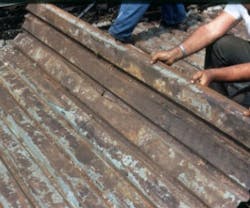As low-slope roof systems approach the end of their life, there are many resources provided by roofing material manufacturers and roof consultants that are available to a building manager. This includes the insulation boards that should be used in retrofit systems, as well as the type of membranes, fasteners, and surfacing that might work best.
Air barriers have recently become the subject of heightened concern as upward flow of moist air during winter conditions can lead to condensation on the bottom surface of the roof membrane. That moisture can result in deck corrosion, a serious safety condition. This is more of a concern with mechanically fastened single ply systems, where the membrane may billow under wind loading.
Richard (Dick) L. Fricklas, received a Lifetime Achievement Award and fellowship from RCI in 2014 in recognition of his contributions to educating three generations of roofing professionals. A researcher, author, journalist, and educator, Fricklas retired as technical director emeritus of the Roofing Industry Educational Institute in 1996. He is co-author of The Manual of Low Slope Roofing Systems (now in its fourth edition) and taught roofing seminars at the University of Wisconsin, in addition to helping develop RCI curricula. His honors include the Outstanding Educator Award from RCI, William C. Cullen Award and Walter C. Voss Award from ASTM, the J. A. Piper Award from NRCA, and the James Q. McCawley Award from the MRCA. Dick holds honorary memberships in both ASTM and RCI Inc.
If those roofs are about to be replaced, that means a lot of construction traffic is likely, which could expose the existing insulation boards and roof fasteners to moisture and allow them to become acidic during the renovation process. Use of cover boards and mechanical fastening may be a safer option to create a viable air barrier. Make sure all of your roof's components help ward off moisture damage with this guide.
What's In a Steel Deck?
Steel is the most common roof deck type in the U.S. Four primary elements must be evaluated to make sure your steel deck is up to par, according to the Steel Deck Institute:
- Gauge (thickness)
- Type (profile)
- Coating
- Grade (strength)
Deck gauge plays an important role in fastener pullout resistance and consequently has an important role in the performance of mechanically fastened roofing systems. Many modern single-ply systems place fasteners at 1-foot intervals (or more), and both deck deflection resistance and adequate withdrawal strength are important. The most common gauge for roofing is 22 gauge (design 0.0295 inches, minimum .028 inches).
When evaluating deck types, remember that A refers to narrow rib, Type F is intermediate rib, and Type B is wide rib.
Grade designations were revised in 2002. Grade C is now referred to as Grade 33 and Grade E is now termed Grade 80. The higher-grade product was introduced to accommodate single-ply roof membranes where greater fastener pullout is needed. Fasteners are spaced at greater distances in an effort to reduce both material and labor on a single-ply roofing project.
A coating specification for galvanized decking is covered by ASTM A653. A common designation for galvanized coating is G-90, where the G indicates that the product is galvanized and the 90 specifies that the coating thickness has a minimum of 0.90 ounces per square foot of zinc coating (the number refers to the total applied to both surfaces of the steel). Galvanized (zinc coated) steel is superior in providing corrosion resistance to painted decking (sometimes called primer).
All of these variables and tools need to be matched to the particular project under consideration. If the building's roofing file is available and up to date and leaks have been promptly repaired, the process of re-covering over steel roof decking should be smooth and satisfactory.
The ABCs of Roof Fire Ratings
Does your roof meet code and insurance requirements?
What Roofing Fire Ratings Mean
The science behind fire performance grades for roofing materials.
Roof Management from Birth to Death
Three steps to extend roof life.
About the Author
Richard L. Fricklas
Richard (Dick) L. Fricklas received a Lifetime Achievement Award and fellowship from RCI in 2014 in recognition of his contributions to educating three generations of roofing professionals. A researcher, author, journalist, and educator, Fricklas retired as technical director emeritus of the Roofing Industry Educational Institute in 1996. He is co-author of The Manual of Low Slope Roofing Systems (now in its fourth edition) and taught roofing seminars at the University of Wisconsin, in addition to helping develop RCI curricula. His honors include the Outstanding Educator Award from RCI, William C. Cullen Award and Walter C. Voss Award from ASTM, the J. A. Piper Award from NRCA, and the James Q. McCawley Award from the MRCA. Dick holds honorary memberships in both ASTM and RCI Inc.
